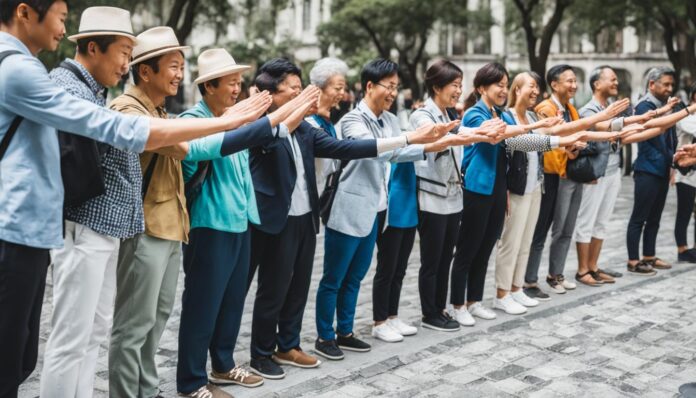As a global traveler, it’s important to understand the customs and traditions of the countries you visit. Showing respect for cultural norms not only fosters positive interactions but also enhances your travel experience. This cultural etiquette guide for travelers will provide you with valuable insight into global traditions and social customs, ensuring that you navigate different cultures respectfully.
Whether you’re traveling for business, study, or leisure, being culturally aware is essential. Not only does it prevent unintentional disrespectful behavior, but it also helps you to build a strong connection with local people.
By following the tips outlined in this guide, you will find it easier to interact with locals and make meaningful connections with people from diverse backgrounds. So let’s get started on your journey to becoming a culturally sensitive traveler.
Understanding Cultural Differences
When traveling internationally, it is important to be aware of local customs and traditions to avoid cultural misunderstandings. To help you navigate these differences, here are some cross-cultural dos and don’ts to keep in mind:
| Do | Don’t |
|---|---|
| Do your research and learn about local customs and traditions before traveling. | Don’t assume that what is considered polite in your own country is universally accepted. |
| Do dress appropriately for the local culture. | Don’t wear clothing that is too revealing or disrespectful. |
| Do be respectful of local traditions, such as removing your shoes before entering a temple or home. | Don’t disregard or disrespect cultural norms and practices. |
| Do be mindful of body language and gestures, which may have different meanings in different cultures. | Don’t use gestures or body language that may be considered offensive or disrespectful. |
Importance of Understanding Cultural Differences
By understanding and respecting cultural differences, you can enhance your travel experience and avoid unintentionally disrespectful behavior. Being aware of local customs and traditions can help you make a positive impression on locals and foster meaningful interactions. By following these cross-cultural dos and don’ts, you can ensure a smooth and enjoyable experience while traveling internationally.
Researching the Destination
One of the most important steps for navigating cultural differences while traveling is researching the cultural norms and practices of the destination before your trip. By doing so, you can better understand the local customs and avoid unintentionally disrespectful behavior, such as using the wrong hand gesture or wearing inappropriate clothing.
For example, in some cultures, talking loudly in public places is considered rude, while in others it is normal. In some countries, it is customary to take your shoes off before entering someone’s home or a temple. Researching these cultural norms and practices can help you show respect for the local culture and make a positive impression as a foreign visitor.
When doing research, there are several reliable resources you can utilize. Online travel forums, cultural guidebooks, and embassy websites are great places to start. Additionally, reaching out to locals through social media or language exchange platforms may provide valuable insights into cultural norms from an insider’s perspective.
“Understanding and respecting cultural differences is essential for traveling abroad. Researching the cultural norms and practices of your destination is a crucial step towards being a cultural aware, respectful traveler.”
Benefits of Researching Cultural Norms
Some of the benefits of researching cultural norms before your trip include:
- Being able to avoid unintentionally disrespectful behavior.
- Showing respect for the local culture and its history.
- Engaging in more meaningful interactions with the locals.
- Reducing the likelihood of cultural misunderstandings.
Overall, researching the cultural norms and practices of your destination can enhance your travel experience and increase your cultural awareness as a foreign visitor. By showing respect for different cultural practices, you can foster positive relationships and build a deeper appreciation for our diverse world.
Dress Code and Appearance
When traveling internationally, it’s essential to remember that the way you dress can have a significant impact on how you’re perceived by locals. To show respect for local customs and norms, it’s crucial to research proper dress codes and appearance guidelines before you depart.
To start, consider the climate and weather conditions of your destination. Dressing appropriately for the weather is not only practical but is also a sign of proper respect and preparation. In many cultures, modesty is also crucial, especially when visiting public places such as places of worship or traditional ceremonies. Be mindful of what you’re wearing and avoid anything too revealing or provocative.
Additionally, some cultures have specific dress codes or traditions that are unique to their rituals or ceremonies. In such cases, it’s advisable to dress accordingly to show respect. Consider packing clothing items that are versatile and can be adjusted to fit different social situations.
Overall, dressing modestly and appropriately is one of the most significant parts of respectful behavior while traveling abroad. By following these etiquette tips, you can avoid unintentional offense and ensure a positive experience for yourself and those around you.
Greetings and Introductions
When traveling internationally, it’s important to be aware of different greeting and introduction customs. While a handshake may be the norm in your home country, it may not be the standard practice in another culture. Some cultures greet with a bow, while others with a cheek kiss. It’s crucial to research the destination’s social customs before your trip to avoid cultural misunderstandings.
Here are some global travel etiquette tips for greetings and introductions:
- Always greet people with respect and a smile.
- Use formal titles, such as Mr., Mrs., or Miss, until invited to use first names.
- Avoid using slang or colloquial expressions when meeting new people.
- Be aware of personal space and avoid invading it when greeting someone.
- If you’re unsure how to greet someone, observe others and follow their lead.
Remember, social customs for international tourists may differ greatly from what you’re accustomed to at home, but following these tips can ensure a respectful and positive interaction with locals.
Examples of Greetings and Introductions in Different Cultures
| Culture | Greeting/Introduction |
|---|---|
| Japan | Bow with eyes lowered to show respect. Address someone using their title and family name. |
| France | Cheek kisses (La bise) for friends, acquaintances, and family members. Use formal titles for strangers. |
| India | Namaste with palms together and a slight bow. Address people using their title and first name. |
| Brazil | Cheek kisses for close friends and family. Firm handshake for formal settings. |
By researching and learning about different cultures, you can be better prepared to adapt to new environments and show respect for the local customs and traditions, making your travels an enriching and positive experience.
Communication and Language
When traveling internationally, communication is essential for building positive relationships with the locals and navigating cultural differences. However, language barriers and cultural differences can make effective communication challenging. To ensure respectful behavior while traveling and to navigate cultural differences, keep in mind the following tips:
- Learn basic phrases in the local language, such as greetings, thank you, and please. This will show your respect for the local culture and make it easier to communicate.
- Avoid using slang, idioms, and humor that may not translate well into the local language. Instead, use simple and direct language.
- Be mindful of your body language and facial expressions, as these can have different meanings in different cultures. For example, direct eye contact may be seen as a sign of respect in some cultures, while in others, it may be considered rude or aggressive.
- If you are having trouble communicating, try using nonverbal cues, such as pointing or gesturing. However, be respectful and avoid offensive gestures that may be considered inappropriate in the local culture.
Remember, respect for cultural differences is key to successful communication while traveling. Don’t assume that everyone will understand your language or cultural references. Take the time to learn about the local culture and be open to learning from the locals.
Dining Etiquette
When traveling abroad, it’s important to be mindful of proper dining etiquette to show respect for the local culture. Customs around food and drink can differ widely between countries, so it’s crucial to research these customs before you go.
Here are some etiquette tips for dining abroad:
- Wait to be seated. In some cultures, it’s considered rude to seat yourself at a restaurant. Wait for the host or hostess to seat you.
- Use utensils properly. Different cultures have their own specific ways of using utensils, so be sure to research the correct way to use them. In some countries, it’s considered rude to eat with your left hand, so make sure you use your right hand instead.
- Be mindful of sharing food. In some cultures, sharing food is a common practice. However, in others, each person is expected to have their own order. Research the customs before you go.
- Tip appropriately. Tipping customs vary widely between countries, so make sure to research the expected amount and whether tipping is customary at all.
By following these etiquette tips, you can show respect for the local culture and have a more enjoyable dining experience abroad.
Gift-Giving Etiquette
Gift-giving is an important aspect of many cultures, and it is essential to follow the local customs and traditions while shopping for and presenting gifts to people. To avoid offending or embarrassing the recipient, it is essential to learn about the cultural norms surrounding gift selection, presentation, and timing. Here are some tips to help you navigate gift-giving etiquette while traveling:
Research Local Gift-Giving Customs
Before buying a gift, research the local customs and traditions of the host culture. Some cultures have specific rules and customs governing gift selection and presentation. For instance, in Japan gift wrapping is considered almost as important as the gift itself. They often wrap gifts with intricate designs and use a unique wrapping style called furoshiki. Knowing such details can help you select an appropriate gift and present it correctly.
Consider Gift Preferences
Consider the recipient’s preferences when buying gifts. For example, if you are buying gifts for a Muslim friend, ensure that they are halal. Alcohol, pork products, and certain food items may be considered offensive in some cultures and religions. If you are unsure about what to give, ask someone familiar with the culture or stick to safe gifts like flowers or local handicrafts.
Avoid Quantity Over Quality
In some cultures, the quality of the gift is more important than the quantity. For example, in China, it is customary to give expensive gifts as a sign of respect and appreciation. However, avoid going overboard with the cost and extravagance of the gifts, as it may be seen as a bribe in some cultures. It’s better to give a thoughtful, practical gift than an expensive one.
Timing is Important
The timing of gift-giving is also essential. In some countries, such as India and China, it is customary to give gifts at the beginning of the relationship to establish trust and build rapport. In other cultures, such as Japan, it is customary to exchange gifts at the end of a business negotiation as a sign of respect and commitment. Therefore, timing is an essential aspect of gift-giving etiquette.
Wrap the Gift Properly
Proper wrapping of gifts is another crucial aspect of gift-giving in many cultures. For instance, gift wrapping in Korea is seen as a way of expressing respect and gratitude to the recipient. Wrapping gifts in colorful paper and adding a ribbon or a bow can show that you have put effort and thought into the gift. Ensure you wrap the gifts appropriately and considerately in accordance with the local customs.
By following the gift-giving etiquette of the local culture, you can show your respect for the customs and traditions and establish a positive relationship with the recipient. Remember, when in doubt, do some research or ask locals for guidance.
Respect for Sacred Sites and Traditions
When traveling to a foreign country, it’s crucial to respect cultural norms for foreign visitors, particularly when it comes to visiting sacred sites and observing local traditions. Navigating cultural differences while traveling requires a heightened sense of awareness and sensitivity to the cultural significance of certain customs and practices.
Whether it’s visiting a temple, mosque, or church, it’s essential to dress appropriately and remove your shoes if necessary. Avoid any behavior that could be perceived as disrespectful, such as taking flash photography or making loud noises.
It’s essential to familiarize yourself with the customs and practices surrounding sacred sites and traditions in the region you’ll be visiting. In some cultures, women may be required to cover their heads or wear long dresses, while in others, visitors may need to be silent or refrain from touching certain objects.
It’s also important to be respectful of religious holidays and cultural traditions that may be taking place during your visit. Take the time to learn about significant dates and events, and avoid any behavior that could be considered disruptive or insensitive.
Tips for respecting sacred sites and traditions
| Do: | Don’t: |
|---|---|
| Research the customs and practices surrounding the sacred site or tradition | Take flash photography or make loud noises |
| Dress appropriately and remove your shoes if necessary | Touch or remove any objects without permission |
| Be respectful of religious holidays and cultural traditions | Display disrespectful behavior or make negative comments about the tradition |
By being mindful and respectful of cultural norms for foreign visitors, you can make an impactful statement, not just to the people around you but also to your own character. Remember that, when we travel, we must put aside our own beliefs to embrace the culture we’re visiting fully. Being open-minded and respectful of other customs and traditions is one of the most rewarding aspects of international travel experience you won’t want to miss.
Nonverbal Communication and Gestures
When traveling abroad, it’s essential to be aware of nonverbal communication and gestures to avoid offending the locals. In different cultures, the same gesture can have completely different meanings, so it’s always better to err on the side of caution and avoid using them altogether.
For example, in the United States, a thumbs-up is a positive sign. However, in some Middle Eastern countries, it’s an offensive gesture.
Similarly, making the “OK” sign with your fingertips touching in a circle is a common gesture indicating approval or agreement in many countries. But in Brazil, Germany, and some other places, it signifies something obscene or vulgar.
To avoid any cultural misunderstandings, it’s always best to stick to verbal communication. If you’re unsure whether a particular gesture is appropriate, it’s better to avoid it altogether.
Remember: Nonverbal communication and gestures can have different meanings in different cultures, so it’s best to avoid them unless you’re absolutely sure they’re appropriate.
Common Gestures and Their Meanings in Different Countries
| Gesture | Meaning in the United States | Offensive Meaning in Other Countries |
|---|---|---|
| Thumbs-up | Positive sign | Offensive gesture in some Middle Eastern countries |
| OK sign (fingertips touching in a circle) | Signifies approval or agreement | Signifies something obscene or vulgar in Brazil, Germany, and some other places |
| Crossed fingers | Common gesture indicating good luck or hope | Offensive gesture in Vietnam and some other countries |
| Beckoning with one finger | Gesture to indicate “come here” | Considered rude in Japan, where beckoning is done with the whole hand |
| Pointing with index finger | Common gesture to indicate direction or object | Considered rude in some Middle Eastern and Asian countries |
“When traveling, it’s important to remember that nonverbal communication can be just as important as verbal communication. Always pay attention to how your actions might be perceived by people from different cultures.”
Conclusion
Congratulations on taking the first step towards becoming a culturally aware traveler. By reading this cultural etiquette guide for travelers, you have shown a commitment to respecting global traditions and social customs while journeying abroad. Remember, understanding cultural differences is crucial to fostering positive interactions and avoiding unintentional disrespect towards local cultures.
Researching the destination’s cultural norms and practices before traveling is vital to navigating cultural differences. Respectful behavior while traveling includes appropriate dress code and appearance, following proper dining etiquette, and being mindful of nonverbal communication and gestures.
By showing respect for sacred sites and traditions and practicing proper gift-giving etiquette, you can enhance your travel experience and build positive relationships with locals.
Overall, by following the cultural etiquette tips outlined in this guide, you can become a responsible and respectful global traveler. Embrace customs and traditions for global travelers, and enjoy the diverse experiences that come with international travel.

















































